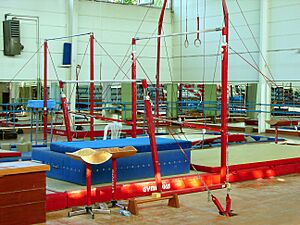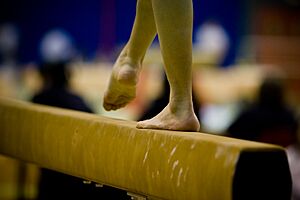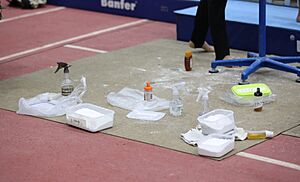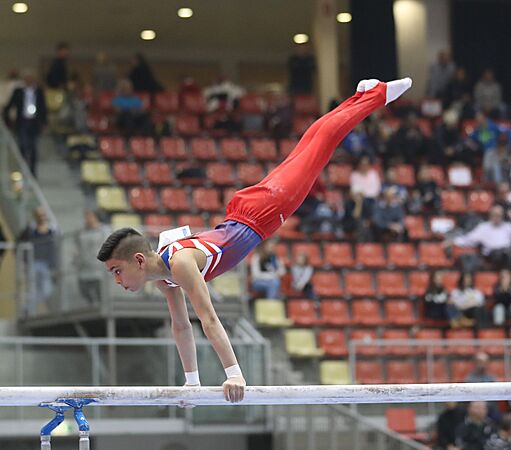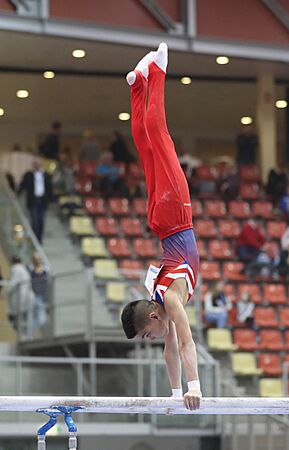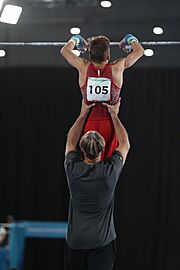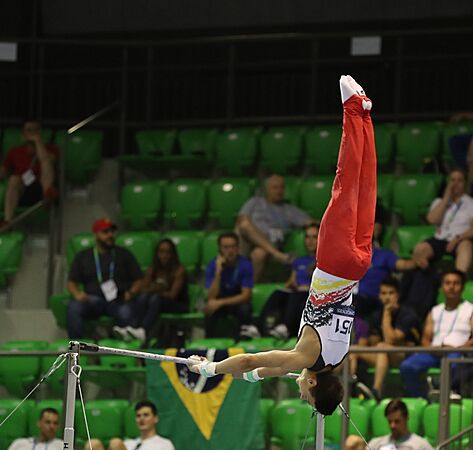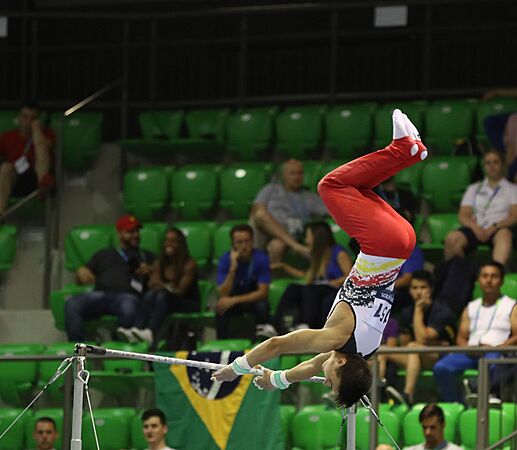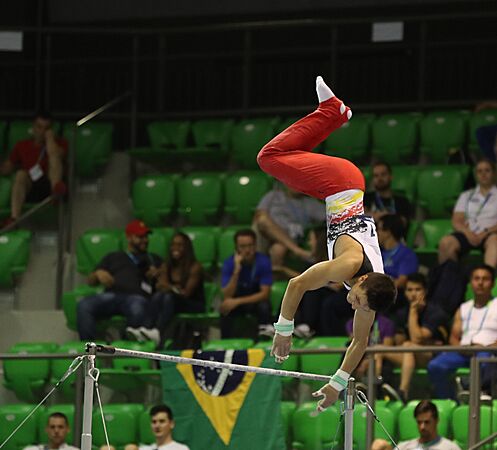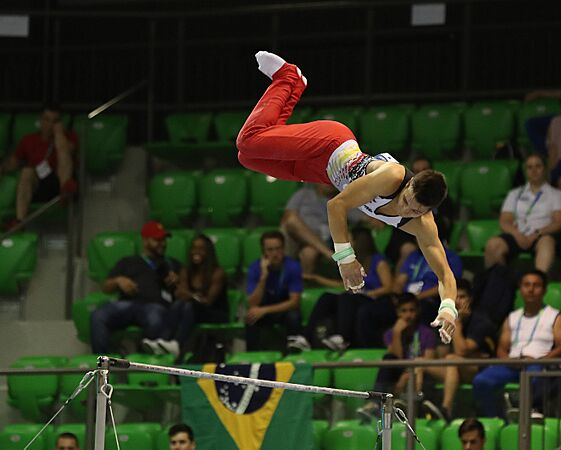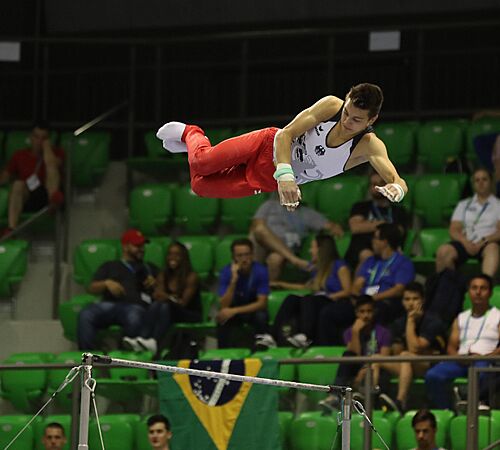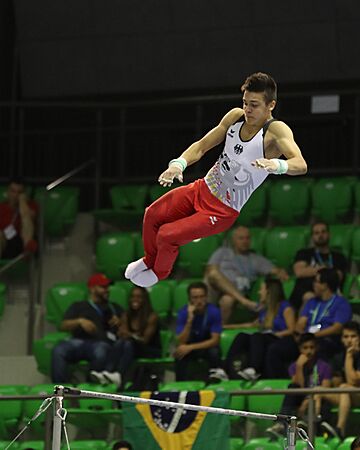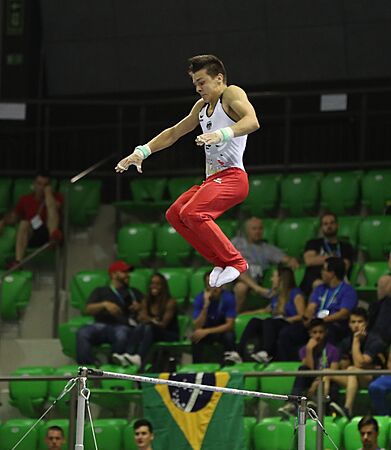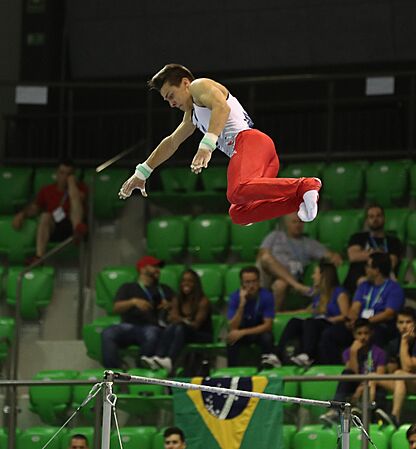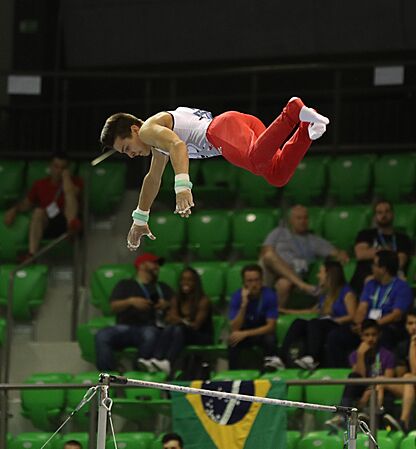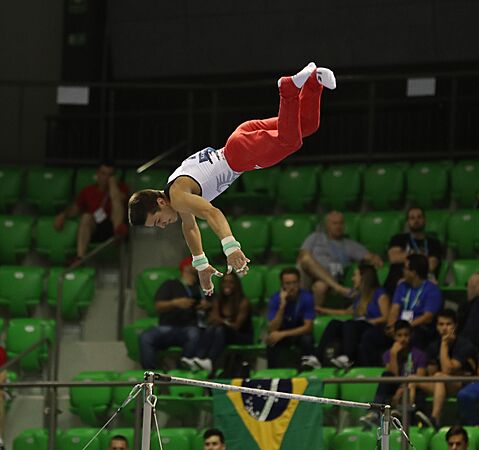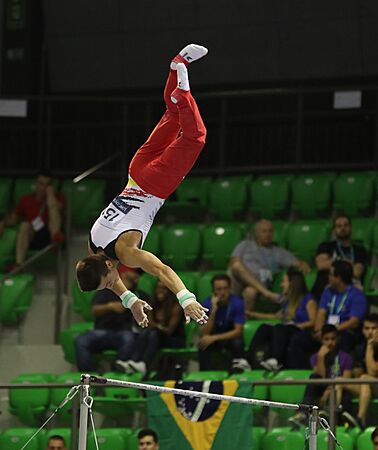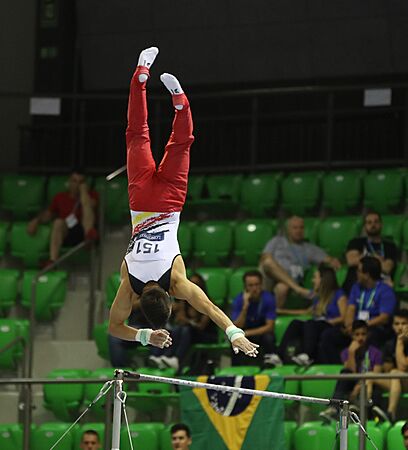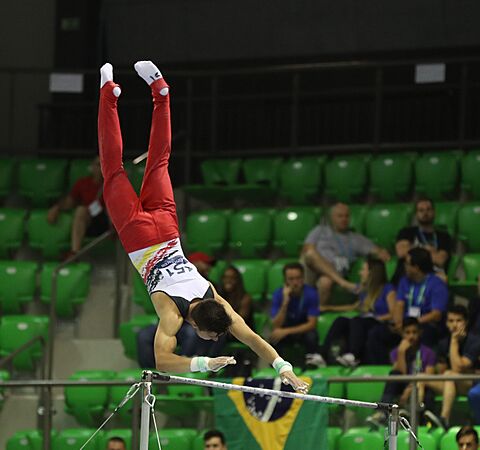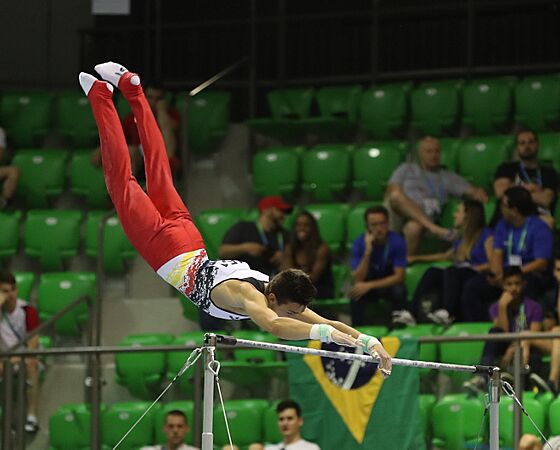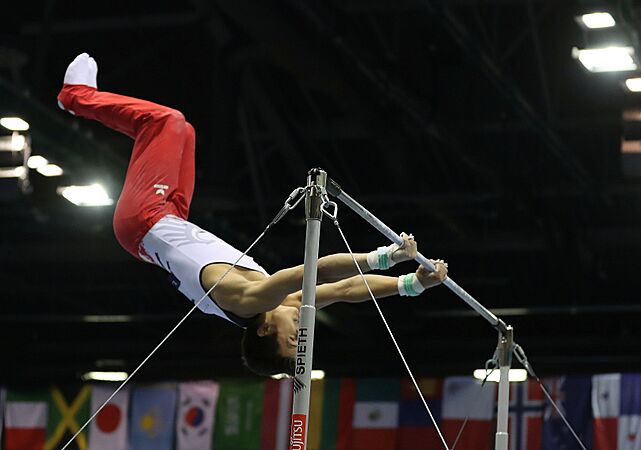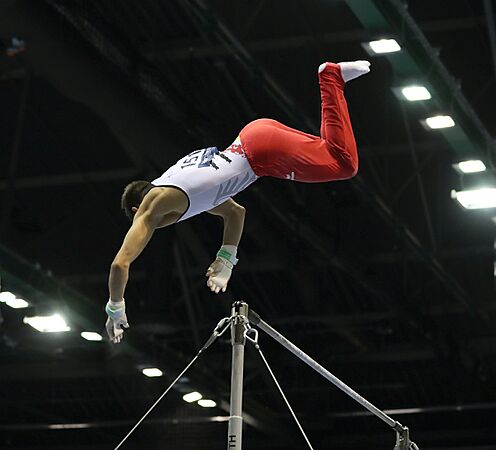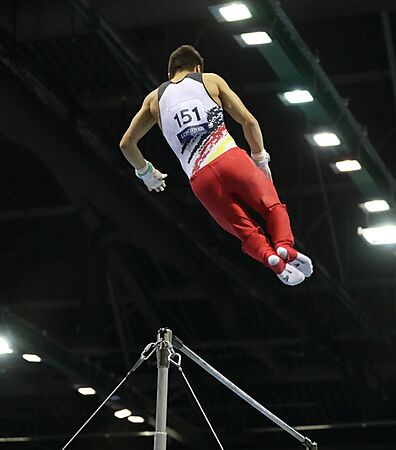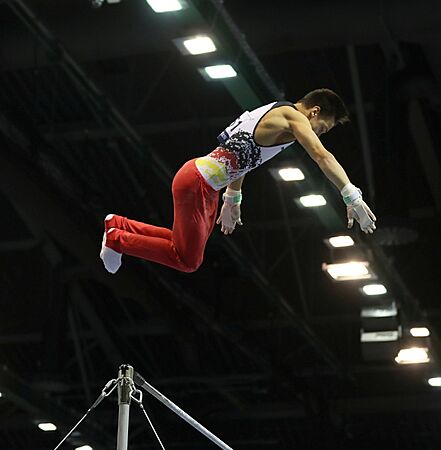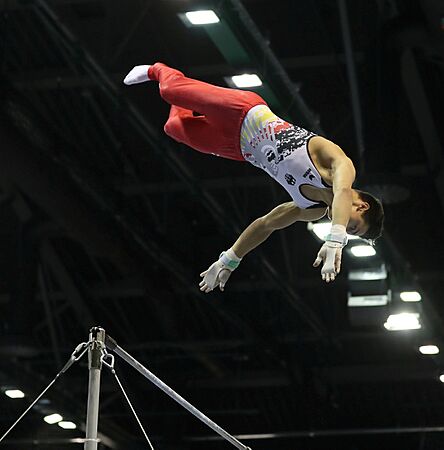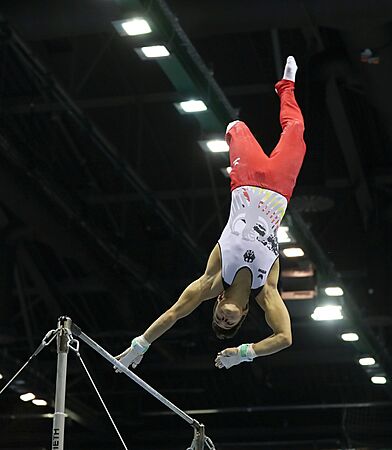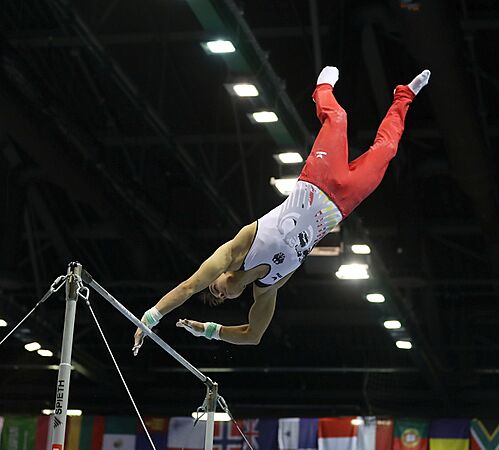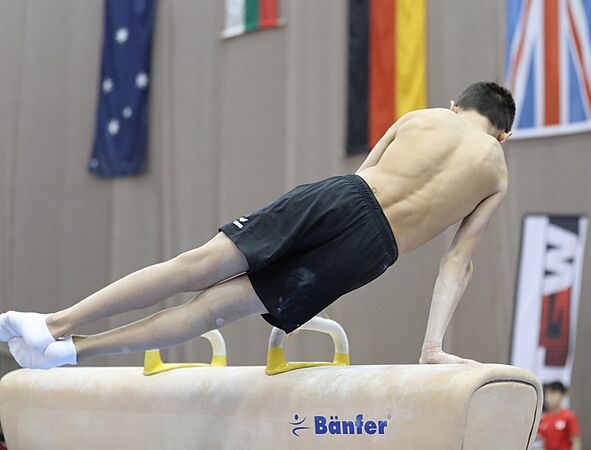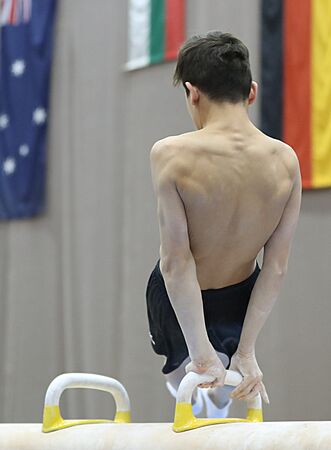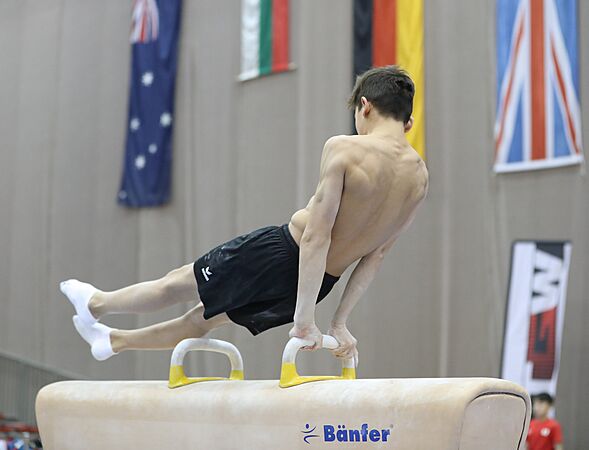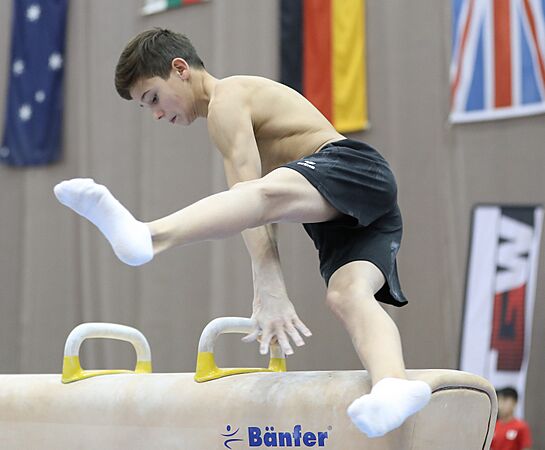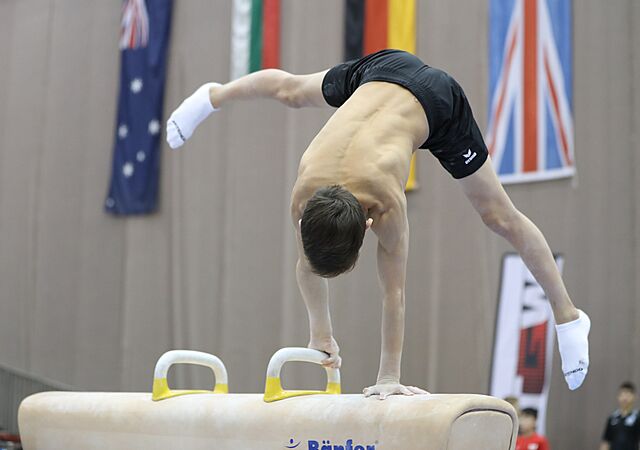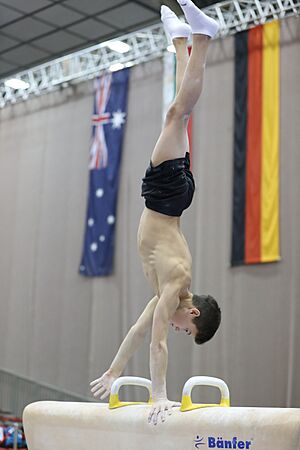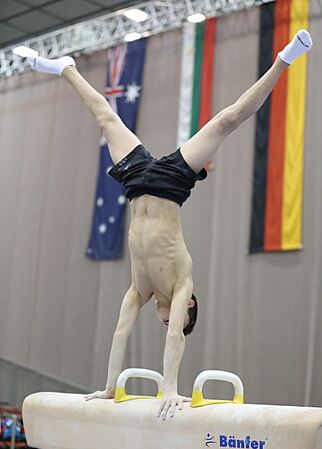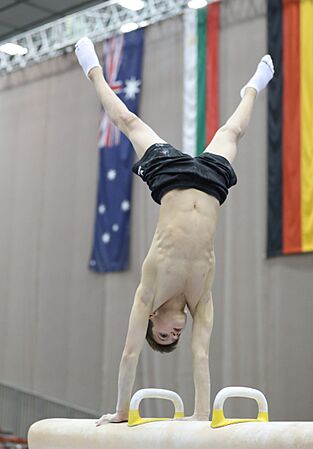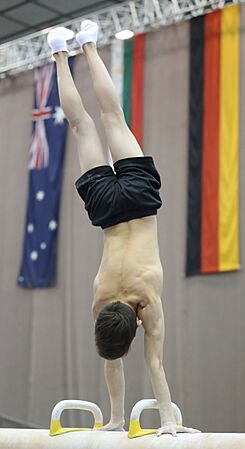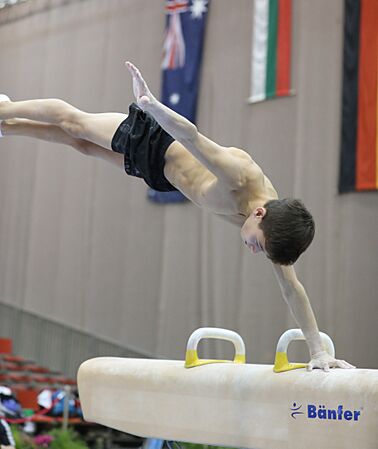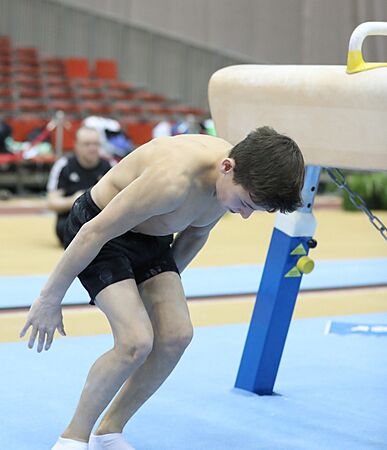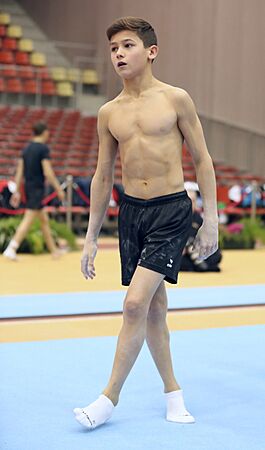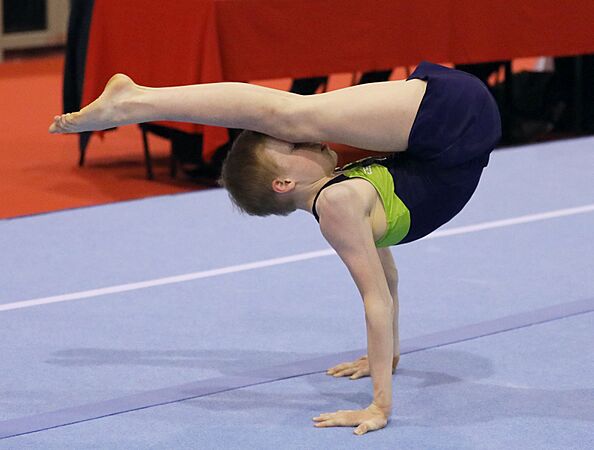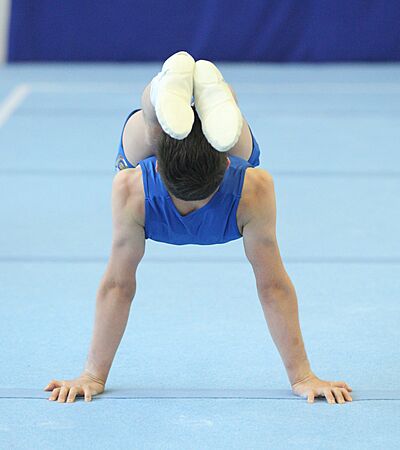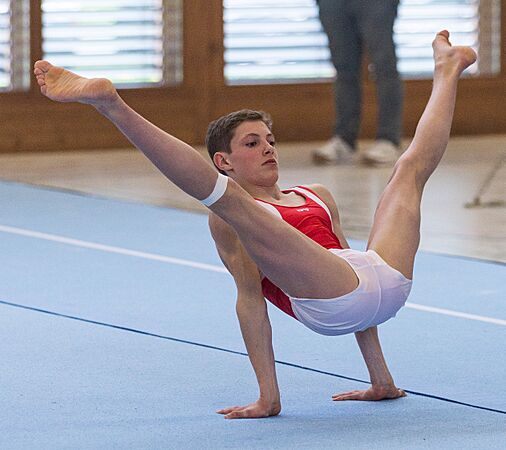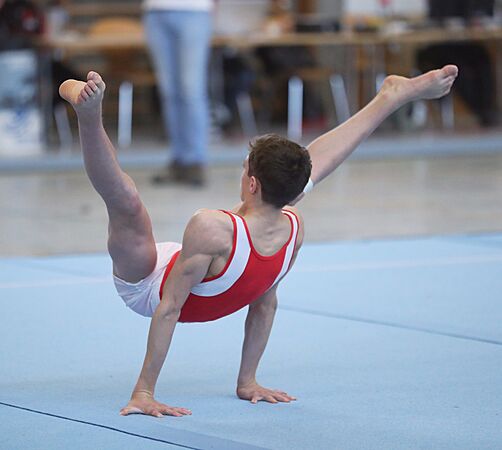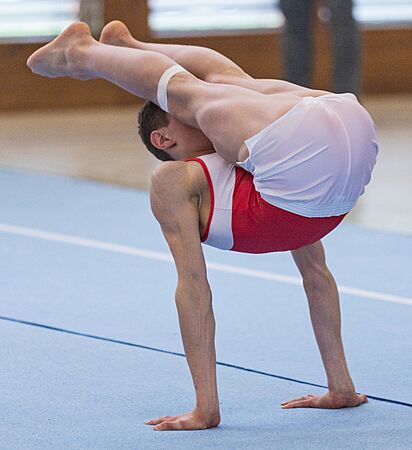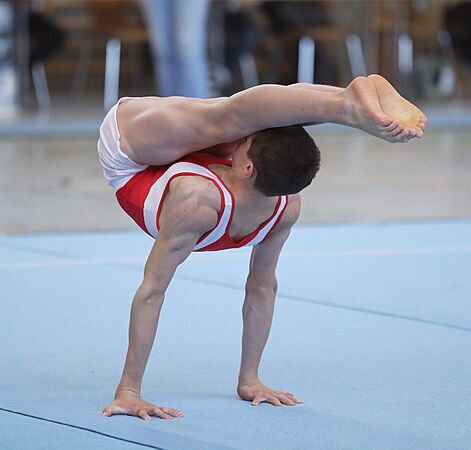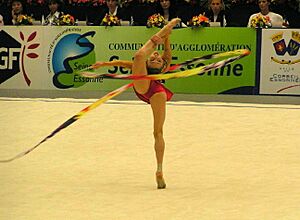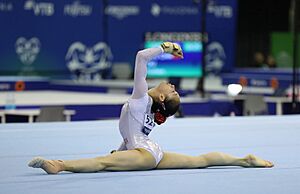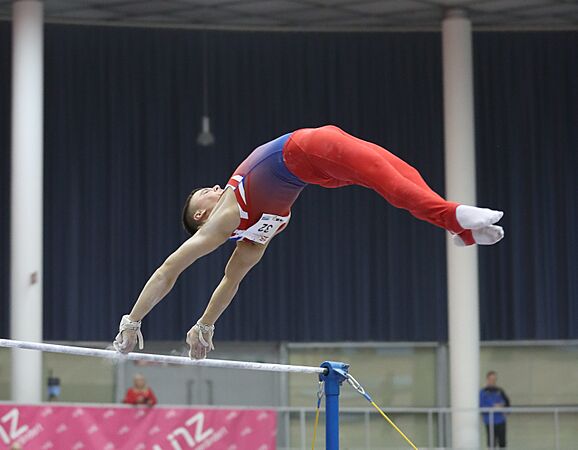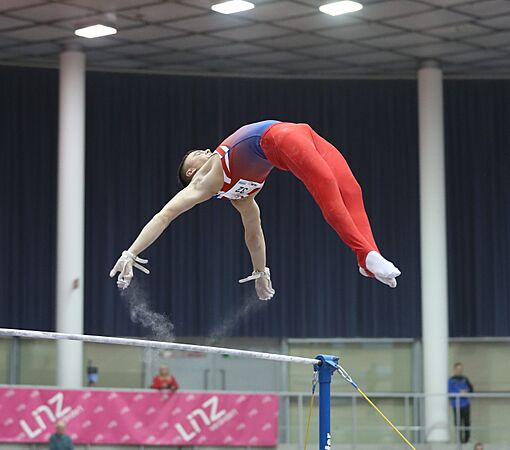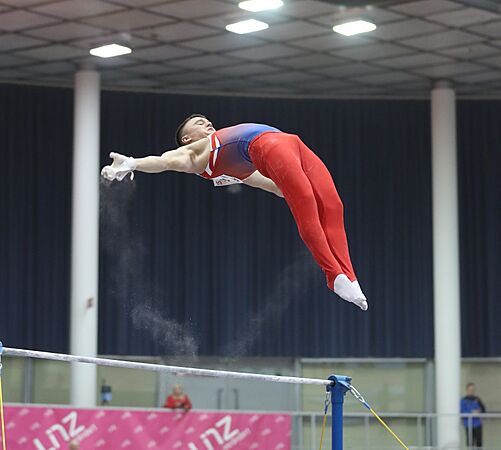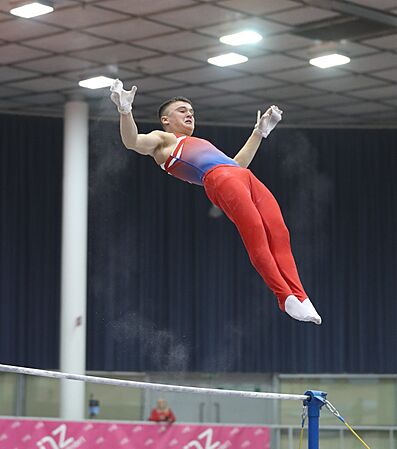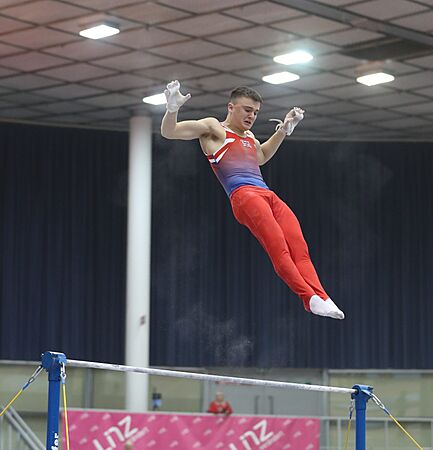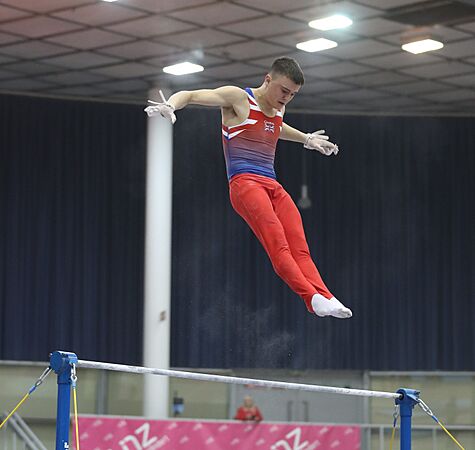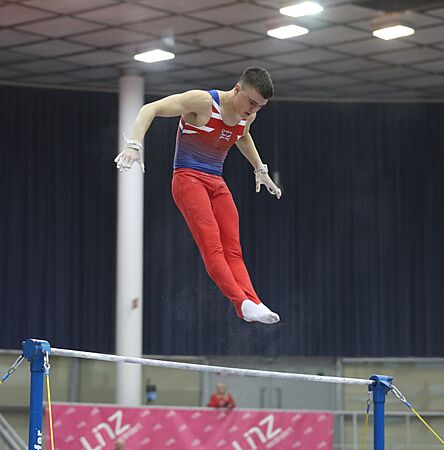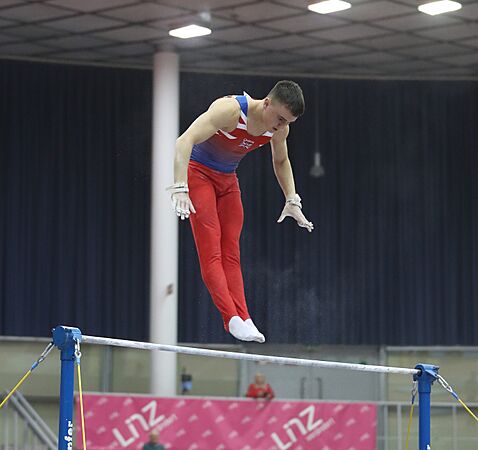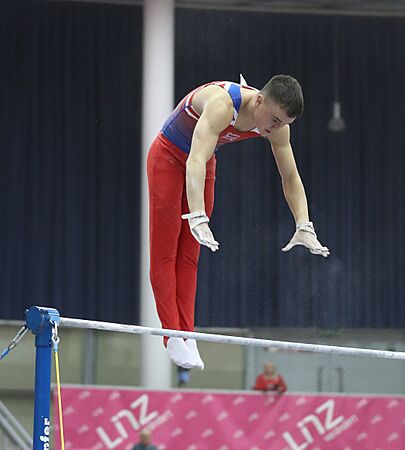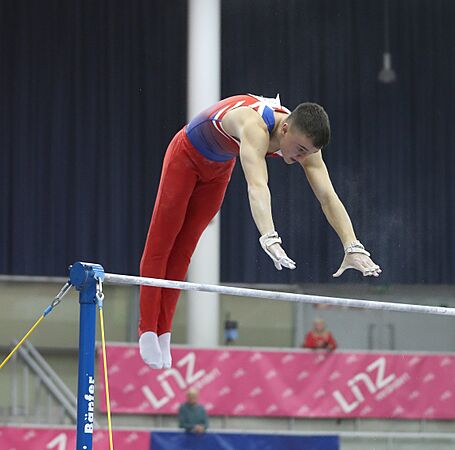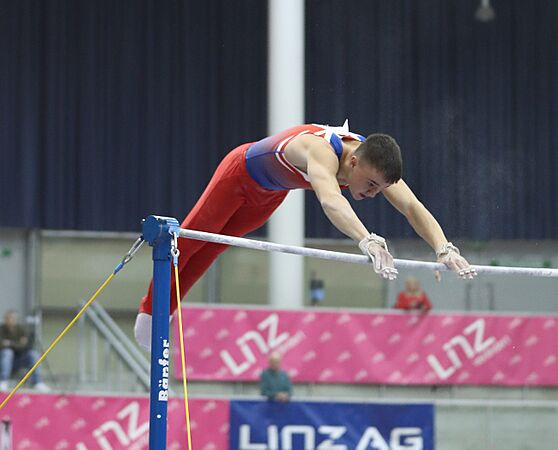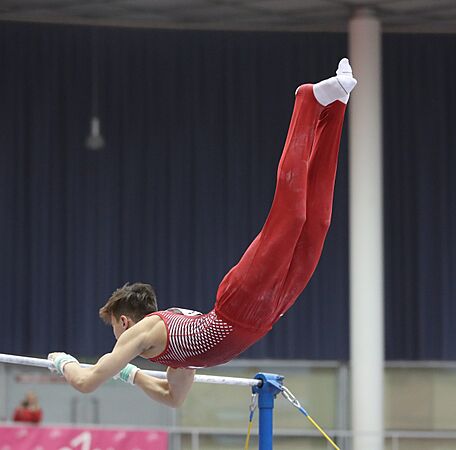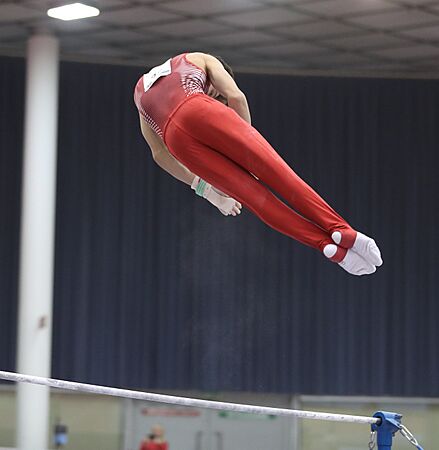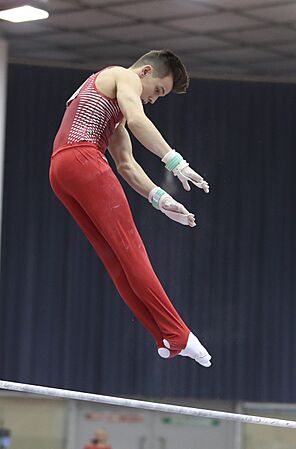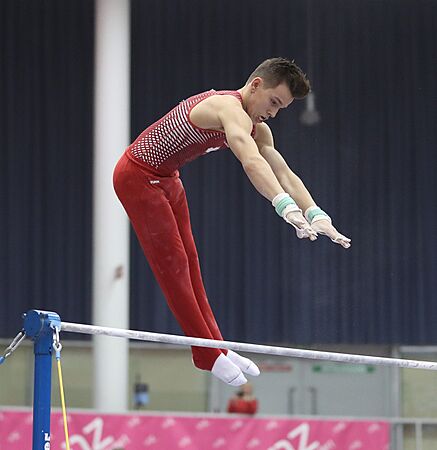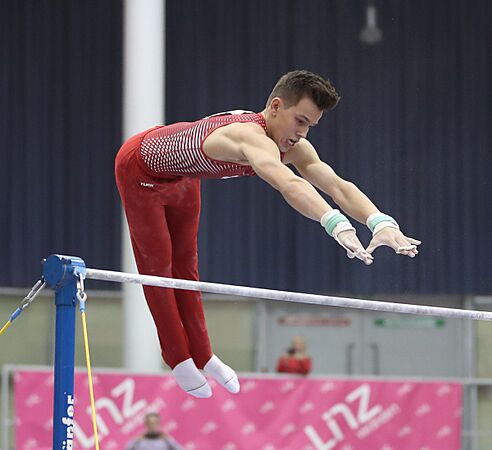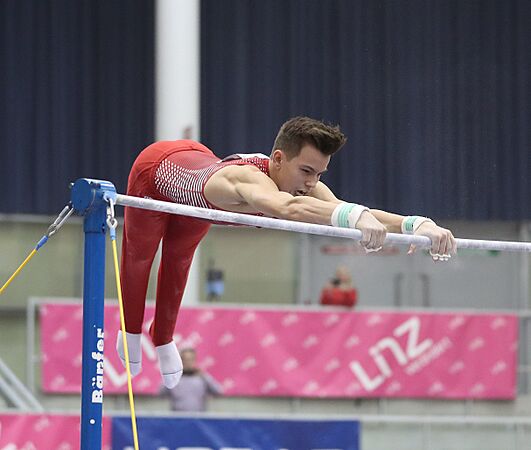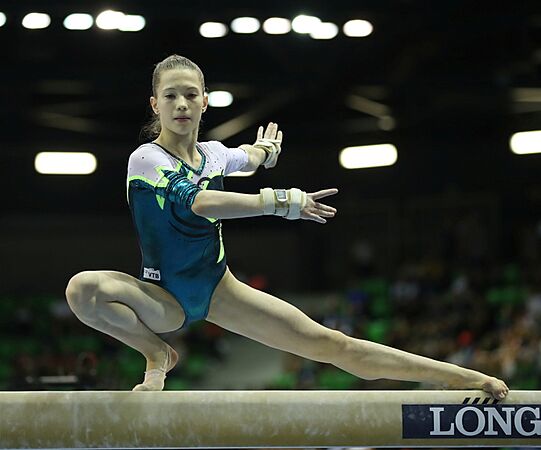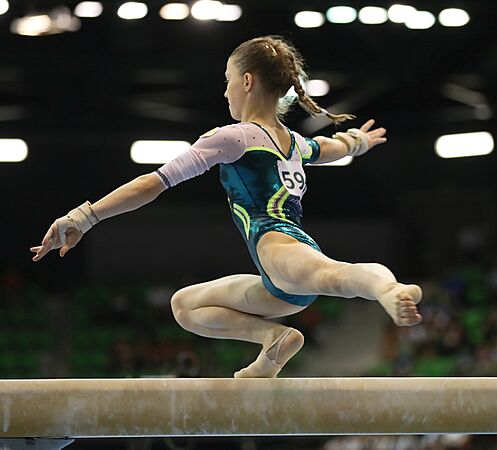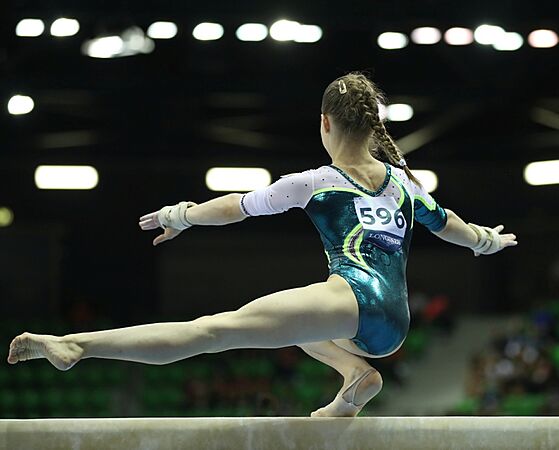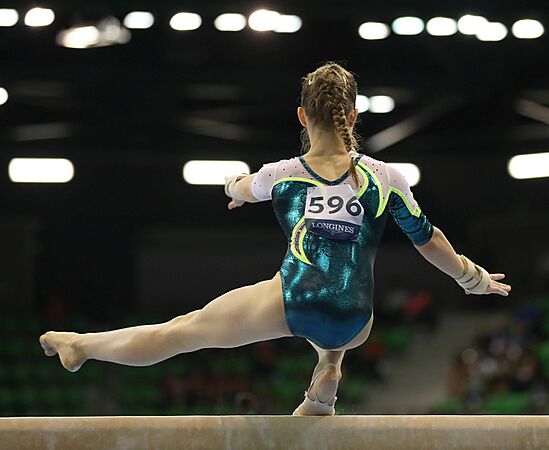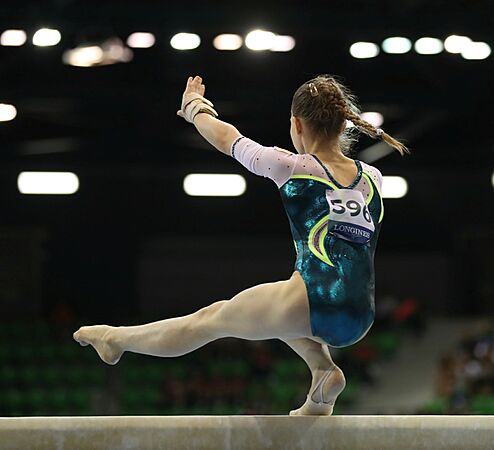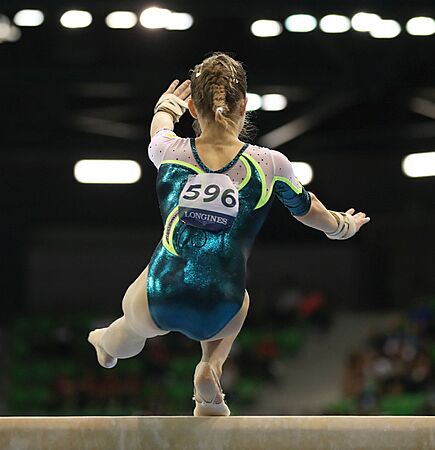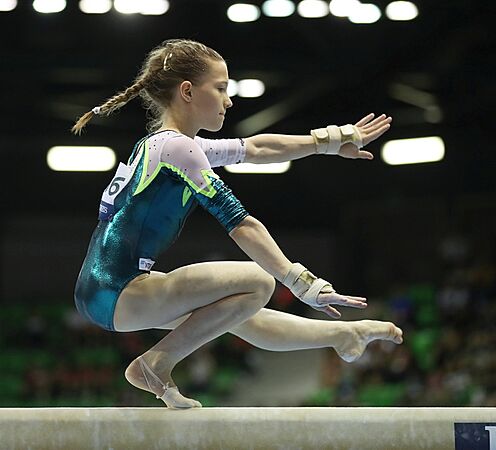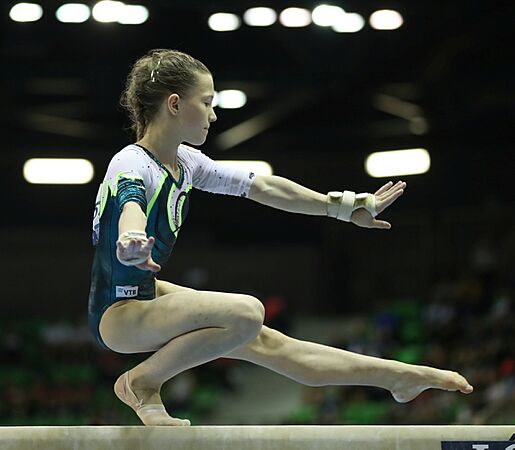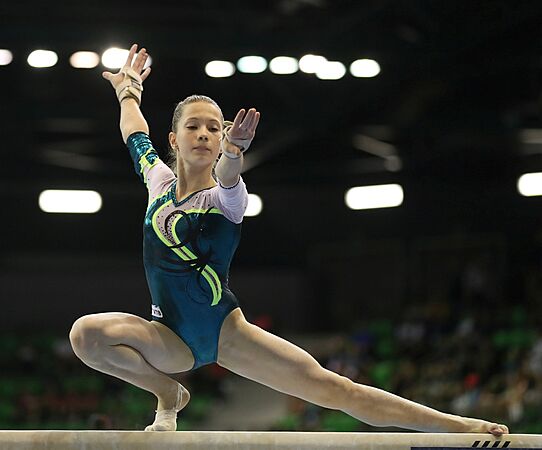Glossary of gymnastics terms facts for kids
Gymnastics is an amazing sport that combines strength, flexibility, and grace! To help you understand all the cool moves and equipment, here's a glossary of terms. It's like a dictionary just for gymnastics, explaining everything from how scores are given to the different types of flips and turns you'll see.
|
Contents
|
A: Awesome Moves and Apparatus
AA
- This is a short way to say all-around.
AB
- A scoring shortcut for the uneven bars, also called asymmetric bars.
Acrobatic Gymnastics
- A type of gymnastics where partners work together. They combine tumbling and strength with dance and flexibility. Routines are performed on the floor.
All-Around
- This means one gymnast competes on all the equipment in a single competition. For girls, it's four pieces of equipment. For boys, it's six.
Amplitude
- This describes how big and high a gymnastic move is. It includes how high you jump, how far you move, and how much your body stretches. Doing moves with great height and extension looks amazing and is very important!
Apparatus
- This is the special equipment used in gymnastics, like the balance beam or the parallel bars.
Arabian
- A type of flip (salto) that starts with a backward movement. Then, you do a half twist right after jumping, and finish with a front flip.
Arabesque
- A beautiful pose where you stand on one leg. The other leg is raised behind you, usually about 45 degrees.
Aerial Cartwheel
- A type of cartwheel where your hands do not touch the ground. It looks like you are flying!
Aerial Twist
- An acrobatic flip where you turn 180 degrees (half a circle) while you are at the highest point of the flip.
Artistic Gymnastics
- A popular type of gymnastics where athletes perform routines on different pieces of equipment, called apparatuses.
B: Balance and Big Skills
Back Handspring
- A skill where the gymnast jumps backward, reaches for the floor with their hands, and then kicks their legs over. The legs stay together throughout the move.
Balance
- One of the routines in acrobatic gymnastics. It focuses on holding steady positions that show strength, balance, and flexibility.
Balance Beam
- A long, narrow platform used by girls in artistic gymnastics. It's only about 4 inches (10 cm) wide! Gymnasts perform tumbling and dance moves on it.
Ball (Rhythmic Gymnastics)
- A piece of equipment used in rhythmic gymnastics. Gymnasts hold it, balance it, and throw it into the air, catching it gracefully.
Banned Skills
- These are gymnastic moves that are not allowed in competitions. They are too risky and could cause serious injuries to the athlete.
Base
- In acrobatic gymnastics, this is the person who supports others in a pair or group. The base needs to be strong and balanced. They are usually the older or larger athlete.
BB
- The short way to write balance beam for scoring.
Bib
- The number worn on a gymnast's back. It helps judges and officials identify each athlete during a competition.
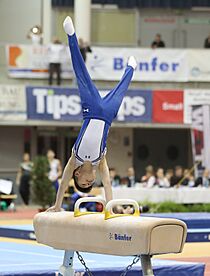
A gymnast performing a Busnari on the pommel horse.
Busnari
- A specific move on the pommel horse. It's a reverse Stöckli straddle through to a handstand. It's named after gymnast Alberto Busnari.
B Turn
- Another name for a back tuck.
C: Cool Choreography and Equipment
Cassina
- A difficult move on the horizontal bar. It's a straight Kovacs with a full twist. Named after Igor Cassina.
Cartwheel
- A move where you go sideways, from hands to feet, in a straight line. Your back, arms, and legs stay straight, and your feet are pointed.
Chalk
- A white powder, like magnesium carbonate, that gymnasts put on their hands, feet, and equipment. It helps them get a better grip and prevents slipping.
Chestroll
- A skill where you bend your back a lot. It's also known as a chin stand.
Circle
- A basic swing on the Pommel Horse. The gymnast moves their legs together in a full circle, supported by both hands.
Clubs (Rhythmic Gymnastics)
- A piece of equipment used in rhythmic gymnastics. Gymnasts use two clubs, tossing and catching them in complex patterns.
Code of Points
- This is like the rulebook for gymnastics. It explains how routines are scored in each different type of gymnastics.
Combined Routine
- In acrobatic gymnastics finals, this routine mixes elements from both the Balance and Dynamic (Tempo) routines.
Competition
- An event where gymnasts perform their routines in front of judges. The judges then give scores and points.
D: Daring Dives and Difficulties
Derwael-Fenton
- A release move on the uneven bars. It involves a backward Stalder, a straddle reverse hecht over the high bar, and a half turn to catch the bar again. Named after Nina Derwael and Georgia-Mae Fenton.
Diamidov
- A swing forward with a full 360-degree turn on one arm. This leads into a handstand on the parallel bars. Named after Sergey Diomidov.
- Execution of the Diamidov by a young gymnast at the Austrian Future Cup 2018
Difficulty Value
- This is how hard a gymnastic move is, according to the Code of Points. Moves are rated from A (easiest, 0.1 points) to J (hardest, 1.0 points). Harder moves get more points!
Dismount
- The skill a gymnast uses to get off a piece of equipment at the end of their routine.
Dive Roll
- A move where a gymnast goes from a handstand into a forward roll.
Dynamic Routine
- One of the routines in acrobatic gymnastics. It combines dance with tumbling and exciting flight elements, like throws.
E: Elite and Essential Skills
EGR
- A short way to say element group requirements.
Element Group Requirements
- These are specific skills or types of skills that a gymnast must include in their routine on each piece of equipment. For example, on uneven bars, a gymnast must perform a release move. There are usually five required skills for each event.
Elite
- This term describes the highest level of competition in gymnastics. An "elite" gymnast competes at this top level.
Elementary Gymnastics
- This is a type of gymnastics training for older gymnasts. It helps them learn the basic moves and understand how gymnastics works.
Elbow Stand
- An upside-down pose where your body is supported only by your forearms.
F: Flips and Floor Fun

Jade Barbosa performing her floor routine. The white lines show the edges of the floor.
Fédération Internationale de Gymnastique (FIG)
- This is the international organization that governs gymnastics worldwide. It sets the rules for all competitions.
Flip
- A move where a gymnast jumps from a handstand, either forwards or backward. They land facing the same direction they started.
Floor (Gymnastics)
- A large, padded mat used in artistic gymnastics. The event performed on it is called Floor Exercise.
Floor Exercise
- The event performed on the floor apparatus. Gymnasts do routines that include tumbling, acrobatic skills, and dance.
Freestyle Gymnastics
- A mix of traditional gymnastics and acrobatic tricks. It includes kicks and leaps inspired by martial arts, parkour, and free running. These powerful moves are often done indoors on special equipment.
Front Handspring
- A gymnastics move where the gymnast runs, places their hands down like a handstand, kicks one leg over, pushes off the ground, and stands back up.
Front Tuck
- Running and jumping off two feet, then turning in the air with knees tucked to the chest, and landing back on two feet.
FX
- The short way to write floor exercise for scoring.
Full
- A flip where the gymnast turns completely (a full twist) in the air.
G: Great Gains and Giants
Gainer
- A gymnastics skill where a gymnast does a backward flip while their body is still moving forward.
Giant
- A move where a gymnast casts into a handstand position and makes a full rotation around the bar. Their body stays in a straight line.
Good Leg Split
- A split where the gymnast's stronger leg is placed forward.
Grip
- See Hand Guard.
Gymnastics
- A sport that involves exercises needing physical strength, agility, and coordination. It has roots in ancient Greek exercises and circus performances.
H: High Bars and Handstands
Hand Guard
- A special glove or wrist strap worn by gymnasts. It protects their hands when they perform on equipment like the bars.
Hanging Position
- The starting position for gymnasts on the still rings and horizontal bar. A coach can help the gymnast reach this position.
HB
- The short way to write horizontal (or high) bar for scoring.
High Bar
- See Horizontal Bar.
Hit
- To perform a routine or skill perfectly, without any big mistakes or deductions. For example, "She hit her dismount!"
Hoop (Rhythmic Gymnastics)
- A piece of equipment used in rhythmic gymnastics. It's a hollow hoop, usually 80 to 90 cm wide.
Horizontal Bar
- A piece of equipment used by boys in artistic gymnastics. It's a single bar, about 2.4 meters long, where gymnasts perform swinging skills. It's also called the high bar.
Handstand
- To stand upside down, perfectly straight, with your hands on the floor supporting your body. Your body should be tight and squeezed.
I: Impressive Illusions
Illusion Turn
- A challenging move where a gymnast spins on one foot. Their chest is very close to the ground during the spin.
Indian Clubs
- A type of exercise equipment, originally from India. They are used to add resistance to movements, helping to build strength and flexibility.
J: Junior Jumpers and Judges
Judges
- Trained experts who watch gymnasts and score their skills on each piece of equipment.
Junior
- A world-class gymnast who is too young to compete as a senior. Juniors are usually between 13 and 15 years old.
Jumps
- Basic gymnastic moves where you jump into different shapes, like straight, tucked, piked, straddle, or split.
K: Kips and Kovacs
Kip (Artistic Gymnastics)
- A basic skill on the uneven bars. It's a way to get from a hanging or standing position onto the bar, ending in a front support or handstand.
Kip (Trampolining)
- A training skill used in trampolining.
Kolman
- A very difficult move on the horizontal bar. It's a Kovacs with a full twist, meaning two backward somersaults and one full twist over the bar. Named after Alojz Kolman.
- Kolman performed by a young gymnast during the 2019 Junior World Artistic Gymnastics Championships
Kolyvanov
- A move on the pommel horse. It starts from a side support, then involves a flair or circle to a handstand, with a big turn (450 degrees or more). Named after Alexander Kolyvanov.
- Execution of the Kolyvanov by the young Timo Eder during training at the Austrian Future Cup 2018
Kovacs
- A double backward somersault performed over the horizontal bar. Named after Péter Kovács.
L: Leaps and Layouts
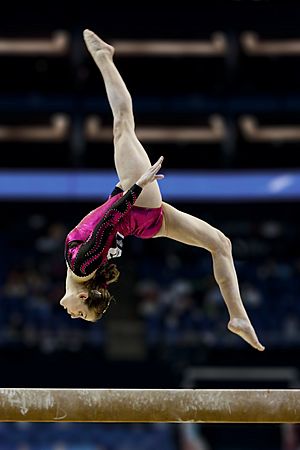
Lauren Mitchell performing a layout step-out on the balance beam.
Layout
- A body position where the gymnast is completely stretched out, with pointed toes and straight legs. A layout salto (flip) is performed in this straight position.
Leotard
- A special one-piece outfit worn by gymnasts for practice and competitions. They come in many colors and styles.
L-Sit
- A strength move where you sit on the floor with your legs straight out in front of you, lifted off the ground. Your body forms an "L" shape.
M: Mighty Moves and Meets
Manna
- A very strong move where the gymnast presses with their hands. They lift their legs and hips until their hips are above their shoulders and their legs are parallel to the floor.
- Execution of the Manna
-
Manna performed by the artistic gymnast Max Krüger at the Swiss Junior Gymnastics Championships 2022 in Lugano.
Master of Sport
- A special title given to gymnasts who compete at the highest level in countries like Russia and other former Soviet republics.
Mat (Gymnastics)
- Soft, padded equipment used in gymnastics to help break falls and keep gymnasts safe.
Meet
- A common word for a gymnastics competition.
Middle
- In acrobatic gymnastics, this is the person in a group who needs a mix of strength, balance, flexibility, and power.
Mount
- The skill a gymnast uses to get onto a piece of equipment at the start of their routine.
N: Numbers and New Moves
Needle
- A move where you place two hands and one leg on the floor. Then, you kick the other leg up into a full split.
Neutral Deduction
- Points taken off a score for rules not directly about the performance. For example, if a gymnast's uniform isn't quite right.
No Handed Forward Roll
- A forward roll performed without using your hands.
Number
- See Bib.
O: Out of Bounds and Onodi
Onodi
- A move that starts like a back handspring with a half turn in the air. It finishes with a front walkover.
One-Handed Cartwheel
- A regular cartwheel, but one hand is kept behind the back instead of touching the ground.
Out of Bounds (OOB)
- This happens on the floor exercise or vault when a gymnast steps or lands outside the marked area. It results in a score deduction.
P: Parallel Bars and Pommel Horse
Parallel Bars
- A piece of equipment used by boys in artistic gymnastics. It has two bars, each about 3.5 meters long.
PB
- The short way to write parallel bars for scoring.
PH
- The short way to write pommel horse for scoring.
Pike
- A body position where your body is bent only at the hips, keeping your legs straight.
Pommel Horse
- A piece of equipment used by boys in artistic gymnastics. It has a rectangular body with two handles, called pommels.
Posture
- How a gymnast holds and moves their body during a routine. Good posture is very important!
Press Handstand
- A move where the gymnast starts in a straddle position on the floor. They then push their body weight onto their hands and slowly press up into a handstand.
Pullover
- A move on the bars where the gymnast starts below the bar. They use their arm strength to pull themselves up and over the bar.
Q: Quick Quasts
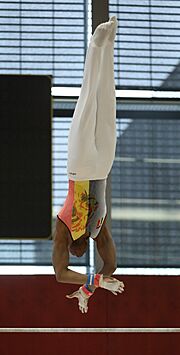
A Belgian gymnast performs a quast over the horizontal bar.
Quast
- A difficult move on the horizontal bar. The gymnast performs a flying giant swing backward with a full twist over the bar. Named after Ralf Quast.
R: Ribbons and Rhythmic Grace
Release Move
- A skill on the uneven bars, parallel bars, or high bar where the gymnast lets go of the equipment. They perform a skill in the air and then catch the bar again.
Ribbon (Rhythmic Gymnastics)
- A piece of equipment used in rhythmic gymnastics. It's a long piece of material attached to a stick, used to create beautiful patterns in the air.
Rhythmic Gymnastics
- A type of gymnastics that combines elements of ballet, dance, and apparatus handling. Gymnasts use equipment like ribbons, hoops, and balls, and are judged on their leaps, balances, and artistic effect.
Rings
- See Still Rings.
Roll
- A rotation of the body over a surface, like a forward roll or backward roll.
Rope (Rhythmic Gymnastics)
- A piece of equipment used in rhythmic gymnastics. It's made of a light, flexible material and has knots at the ends.
Roundoff
- A move similar to a cartwheel. The gymnast pushes off the ground and lands on two feet, facing the direction they started. It's often used to begin a tumbling pass.
S: Somersaults and Splits
Salto
- Another word for a somersault.
Score Protest
- A formal request made by a gymnast, coach, or team to review a score they believe is incorrect. This must be done quickly during the competition.
Senior
- A world-class gymnast who is at least 16 years old (or will turn 16 in the current calendar year).
Somersault
- A gymnastics move where a person rotates their body completely, moving their feet over their head.
Specialist
- A gymnast who is exceptionally good at one or two specific events. They often only compete on those events.
Springboard
- A piece of gymnastics equipment used for vault. It's also an optional aid for getting onto the parallel bars, balance beam, and uneven bars.
SR
- The short way to write still rings for scoring.
Start Value (SV)
- In older scoring systems, this was the highest score a gymnast could get for a routine before deductions. It was based on the difficulty of their skills.
Stick
- To land an acrobatic skill, jump, or dismount perfectly, without taking any steps, stumbling, or making errors.
Still Rings
- A piece of equipment used by boys in artistic gymnastics. It has two swinging rings hanging from a frame. Gymnasts perform strength and swinging skills on them.
Straddle
- A sitting position where your legs are spread wide apart. It can also be performed in the air or at height.
Stuck Landing
- A perfect landing, with no steps, stumbles, or errors.
Splits
- A move where the gymnast sits on the ground with one leg stretched forward and the other stretched backward, forming a straight line.
T: Tumbling and Twists
Tap Swing
- A swing on the uneven bars or horizontal bar. Gymnasts change their body position (hollow to arched and back to hollow) to gain speed and power for moves like release moves or dismounts.
Team Final (TF)
- A competition where teams of gymnasts (usually six, or five at the 2012 London Olympics) represent their country.
Tkatchev
- A release move on the horizontal bar. The gymnast swings forward and vaults backward in a piked position to catch the bar again. Named after Aleksandr Tkachyov.
- Execution of Tkatchev stretchedby Matthew Boardman at the Austrian Future Cup 2018
Toe Shoes
- Special shoes often worn by rhythmic gymnasts for turns. They cover only the toes, similar to ballet shoes. Artistic gymnasts might wear one on the balance beam or floor for turns.
Top
- In acrobatic gymnastics, this is the person in a pair or group who is lifted and emphasizes flexibility and agility. The top is usually a younger, smaller athlete.
Tsukahara (Vault)
- A type of vault. It involves a half turn off the springboard onto the vault table. Then, the gymnast pushes backward, usually into a back flip or layout. Any vault with a handspring and a quarter to half turn onto the table, followed by a backward flip, is a Tsukahara-style vault. Named after Mitsuo Tsukahara.
Tumbling
- The acrobatic skills performed on the floor exercise and balance beam, like back handsprings and flips. Tumbling is also a specific type of gymnastics performed on a long, bouncy track.
Tumbling Run (Tumbling Pass)
- A series of acrobatic skills performed across the floor mat. It usually starts with a run and a hurdle, ending with a big flip.
Tuck
- A body position where your knees are pulled tightly to your chest.
Twist
- A layout (straight body flip) that also includes a rotation of the body around its long axis.
V: Vaults and Voronin

Diego Hypólito rotates in the air after the vaulting table.
Vault (Gymnastics)
- A piece of equipment used by both boys and girls in artistic gymnastics. It's also the name for the skills performed on it, which involve jumping over the vault table.
Voronin
- A move on the horizontal bar. It's a back uprise and a piked vault with a half (180-degree) turn to catch the bar again. Named after Mikhail Voronin.
- Execution of the Voronin by Evgeny Siminiuc at the Austrian Future Cup 2018
VT
- The short way to write "vault" for scoring.
W: Warm-ups and Wolf Turns
Warm-up
- The exercises and techniques gymnasts use before training or competing. This helps warm up their muscles and prevent injuries.
Waterfall
- A move where you go into a handstand, then tuck your chin and arch your back.
Wolf Turn
- A turn performed in a tuck stand on one leg. The other leg can be in various positions. It's done on the balance beam or floor exercise. The triple wolf turn is named after Lauren Mitchell.
- Execution of the wolf turn performed by Vladislava Urazova at the 2019 Junior World Championships
Y: Yurchenko Vaults and Loops
Yurchenko Loop
- A balance beam skill. The gymnast stands sideways, dives backward into a back handspring (the "loop"), grabs the beam, does a back hip circle, and ends in a front support position. Named after Natalia Yurchenko.
Yurchenko Vault
- A type of vault. It starts with a round-off onto the springboard, then a back handspring onto the vault table, followed by a flip (salto). Any vault with a round-off and back handspring entry is called a "Yurchenko-style" vault. Named after Natalia Yurchenko.

All content from Kiddle encyclopedia articles (including the article images and facts) can be freely used under Attribution-ShareAlike license, unless stated otherwise. Cite this article:
Glossary of gymnastics terms Facts for Kids. Kiddle Encyclopedia.

